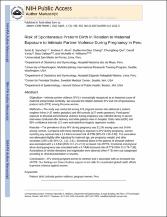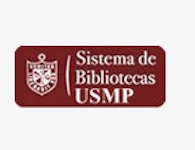Risk of spontaneous preterm birth in relation to maternal exposure to intimate partner violence during pregnancy in Peru

Ver/
Trabajo
(application/pdf: 297.9Kb)
(application/pdf: 297.9Kb)
Fecha
2013-04Autor(es)
Sanchez, Sixto E.
Alva, Andrea V.
Diez Chang, Guillermo
Qiu, Chungfang
Yanez, David
Gelaye, Bizu
Williams, Michelle A.
Metadatos
Mostrar el registro completo del ítemResumen
Intimate partner violence (IPV) is increasingly recognized as an important cause of maternal and perinatal morbidity. We assessed the relation between IPV and risk of spontaneous preterm birth (PTB) among Peruvian women. The study was conducted among 479 pregnant women who delivered a preterm singleton infant (<37 weeks gestation) and 480 controls (≥37 weeks gestation). Participants’ exposure to physical and emotional violence during pregnancy was collected during in-person interviews conducted after delivery and while patients were in hospital. Odds ratios (aOR) and 95 % confidence intervals (CI) were estimated from logistic regression models. The prevalence of any IPV during pregnancy was 52.2 % among cases and 34.6 % among controls. Compared with those reporting no exposure to IPV during pregnancy, women reporting any exposure had a 2.1-fold increased risk of PTB (95 % CI 1.59–2.68). The association was attenuated slightly after adjusting for maternal age, pre-pregnancy weight, and other covariates (OR = 1.99; 95 % CI 1.52–2.61). Emotional abuse in the absence of physical violence was associated with a 1.6-fold (95 % CI 1.21–2.15) increased risk of PTB. Emotional and physical abuse during pregnancy was associated with a 4.7-fold increased risk of PTB (95 % CI 2.74–7.92). Associations of similar directions and magnitudes were observed when PTB were sub-categorized according to clinical presentation or severity. IPV among pregnant women is common and is associated with an increased risk of PTB. Our findings and those of others support recent calls for coordinated global health efforts to prevent violence against women.
Colecciones
- Artículos [274]
Materias
Editor
Springer Nature
Acceso
info:eu-repo/semantics/openAccess
Financiamiento
National Institutes of Health (NIH), National Institute of Minority Health and Health Disparities (T37-MD-001449) and the Eunice Kennedy Shriver Institute of Child Health and Human Development (1R01-HD-059835).
Recurso(s) relacionado(s)
https://www.ncbi.nlm.nih.gov/pmc/articles/PMC3565008/https://doi.org/10.1007/s10995-012-1012-0







